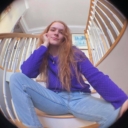In her photographic practice, young Slovakian artist Maria Svarbova brings forth a simplistic and powerful take on everyday mundane activities. Born in 1988, Svarbova is studying Restoration and Archaeology but her successful photography career has already taken flight.

Much of the intrigue in her photographs comes from how Svarbova leverages space and colour in her compositions. With an interest in Socialist architecture and daily life, her photographs capture the systematic unity and collectivism which these ideologies encompass. 1Socialism encourages the view of everything being of benefit to the public rather than for a select few. For comparison, this highly differs from the Capitalist view, which primarily values private ownership which can create opportunity for a small minority to gain extreme wealth.
The cool and silent tension conjured by these staged photographs mirrors what many visualized in the dystopian worlds described in classics such as The Giver by Lois Lowry, Brave New World by Aldous Huxley, and in George Orwell’s 1984. These novels often present ‘utopian’ societies, which quickly unravel into dystopian realities.
Svarbova is able to capture exactly what these authors have the ability to fabricate so well with their words. While the photographs present orderly and nearly perfect situations, there is a strong sense of tension not only in the subjects, but the environment itself. Settings are minimally kept featuring muted pastel tones. Nothing in the photographs appear overwhelming or out of place, if anything the photographs should appear calming due to its subject, palette, and precision.
However it is this attention, to every minor detail, which creates the opposite reaction. There is an inherent uncomfortable suspense when something is “too perfect”, and this urge for imperfection is what creates this visual tension.
Svarbova’s series titled “The Butcher” specifically brings forth these mechanical mannerisms and mindless actions portrayed in these fabricated worlds.
Works by director Wes Anderson, who similarly uses a strong pastel palette in his very methodically cinematic sets, can be a strong comparison for the young photographer. Both artists create a surreal experience for the viewer, curating a nostalgic tone to their works.
Both artists utilize our brains’ hardwired attraction to symmetry. In a world flooded with chaos, a symmetrical composition presents a sense of order and ‘completeness’. As previously mentioned, the nostalgic atmosphere conjured by both artists’ use of colour and composition also plays a large role in this familiar calm. A successful balance is difficult to achieve, specifically when including both human subjecture and setting. Though both Svarbova’s images and Anderson’s frames are strategically curated, there is a raw and vulnerable atmosphere created. Part of which is due to the nostalgic elements, but also the use of their subjects being completely embedded into their vision.
Instead of her characters being the focus of the composition, they are merged within the scene to create a unified image. The setting and subjects hold a similar weight within the pieces, allowing every detail to stand out. Svarbova’s characters become embedded with their respective landscapes, through their attire, expression, and purposeful presence.
For more of Svarbova’s work, visit her website.




